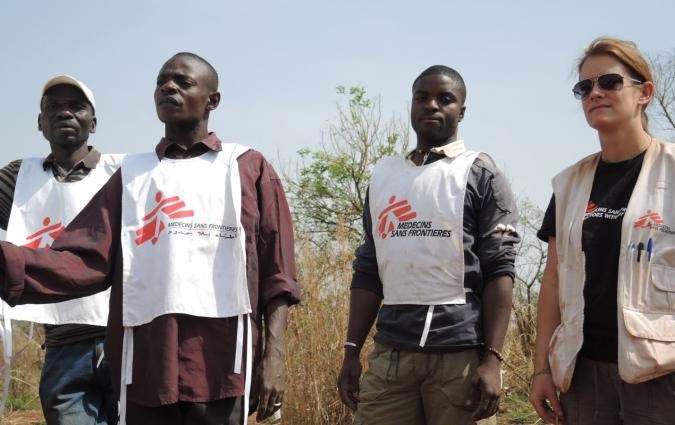Six tips to take care of your mental health while covering the war in Ukraine from afar

Children look out from a train from Kyiv to Lviv as they say goodbye to their father. REUTERS/Gleb Garanich
Since Putin’s troops invaded Ukraine, newsrooms from all over the world have relentlessly covered every aspect of the war, from he bombing of residential buildings to the refugee crisis on the Polish border. Thousands of reporters and editors have been monitoring the situation from afar, by checking updates on social media and agency wires, and by speaking to colleagues and contacts on the ground.
Hannah Storm is a journalist and a media consultant who advises newsrooms on journalists’ safety and mental health issues. I spoke to her earlier this week about these journalists who are exposed to vicarious trauma, as they engage emotionally with a situation they’re witnessing second-hand. These are Hannah’s five tips for reporters and three tips for managers in newsrooms around the world.
A tip for everyone
Acknowledge what we have all been through. “People are very, very tired after the pandemic, it's been a really gruelling couple of years. And I think it's really important to acknowledge that as the starting point, because it's not like we're all coming into this really fresh,” Hannah said. Our current experiences are not happening in a vacuum. They are building on everything we have already lived through.
Five tips for reporters
1. Handle traumatic material with care. “A lot of people have referred to the materials that people are going to be processing as a kind of radioactive material. So you have to treat the material that you're seeing, the stuff coming in, the traumatic imagery coming in in a different way that you might treat other stuff to recognise the fact that this material is going to be difficult to deal with and therefore you need to limit your exposure,” she said.
When dealing with upsetting photos and videos, Hannah suggests focusing on a detail such as a colour, away from the most traumatic part of the image, or minimising your screen, to help you put what you’re seeing in the context that you are in. For videos, she suggests watching the visuals without the audio first, and adding it in later.
2. Limit your exposure. “I think the first thing will be to limit your exposure to the material in terms of what you see, how long you see it for, where you are when you manage it,” said Hannah, who suggests setting yourself a time limit to deal with the most upsetting material before taking a break.
3. Acknowledge how this is affecting you. “In the work I've done around mental health, one of the things that's really important is awareness, and noticing how that image impacts us,” Hanna said. “We carry trauma in different places in our body. So my heart might start racing or my palms might become sweaty or my breathing might be a bit quicker. Noticing that and then trying to find somewhere to ground yourself [is important],” Hannah said. There are many methods to do so, such as the 54321 technique.
4. Set and respect boundaries between your work and home life. “We've established these kinds of parameters, to protect ourselves and to create a separation between our work life and our home life. It's even more important to ensure that those boundaries are watertight in situations such as this,” Hannah said. It’s important to switch off, to take time to do something you enjoy.
5. Talk about it. “Speak with somebody. Find somebody you trust or you could connect to about this, and recognise that those images might have an impact on you,” Hannah said. Be intentional about it, especially if you’re working remotely and can’t count on a spontaneous chat with a colleague. For example, you can schedule a call to check-in.
Three tips for managers
1. Recognise that different people have different reactions. “It's really important to recognise that different people respond to things in different ways. And it's really important to try to ensure that you're never putting pressure on people to agree to something that they might not feel comfortable doing. So there has to be a degree of agency and control given to people,” Hannah said.
There may also be some people more suited to this kind of work than others due to personal circumstances, for example. This is where it’s important for managers to have a good relationship with their workers so that they’re aware of these issues, Hannah said.
2. Lead by example. “Speak with people about expectations and say, ‘Look, this might be difficult to deal with. And actually, I want you to ensure that you limit your exposure to this. And I'd like you to check in with me afterwards on this.’” Otherwise, Hannah said, people may feel compelled to keep going even when it’s harming them.
3. Do not underestimate the power of validation. “We can’t underestimate validation and the importance of saying to somebody, ‘Thank you so much for doing this piece of work, I recognise it's difficult.’ It's profoundly important to validate people's experiences,” Hannah said. It can be that simple and quick, but your reporters will appreciate it, and know that you are aware that what they’re doing is hard.
Hannah Storm is the founder and co-director of Headlines Network, which was set up to promote more open conversations about mental health in the news media.
If you want to know more…
Read this piece by psychologist and journalist Sian Williams
Check out this article by Meera Selva and Anthony Feinstein on the mental toll on journalists covering the COVID-19 pandemic
Read this report from Hannah Storm and Anthony Feinstein on the emotional toll of covering the refugee crisis
Watch our seminar with Hannah from September 2020







